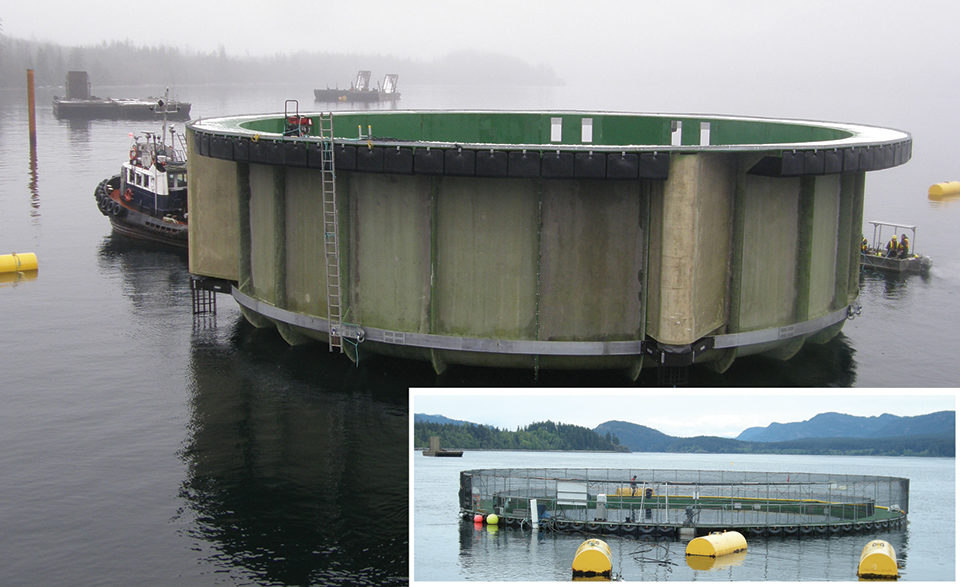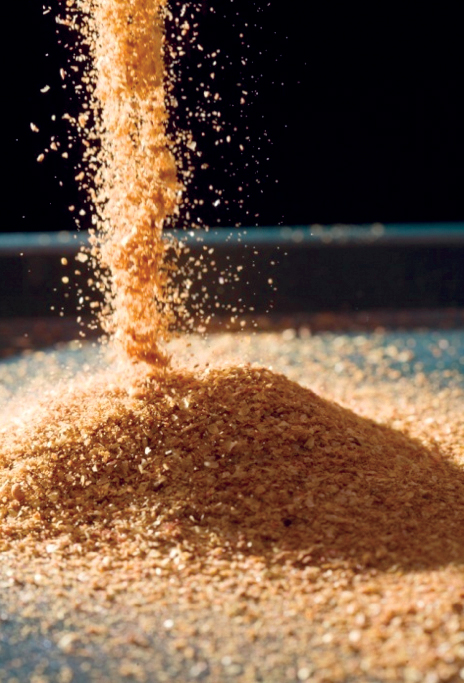Sustainable, economically efficient solution for finfish culture

In recent decades, seafood production has reached a point of maximum sustainable yield. For many species, including salmon, Atlantic cod and tuna, wild catches have declined due to overfishing and habitat destruction.
Aquaculture has grown to fill the widening gap between supply and potential demand, and almost half of global seafood demand is now provided from intensive aquaculture production. Aquaculture has problems of its own, though.
Ocean water quality is not always consistent or optimal for fish growth, and wastes from net pen fish farms can harm the environment. Moreover, net pens are very transparent to interactions between the farmed fish and wild aquatic life. Predators become persistent in seeking ways to attack the fish, and toxic plankton drift into the pens, often killing entire groups. Wild fish, drawn by uneaten feed drifting through the porous walls and floors of the net pens, can exchange parasites and diseases with the farmed fish.
Closed-containment aquaculture
A consistent, optimum rearing environment can be provided by land-based recirculating aquaculture systems, also called RAS systems. These facilities include screens to remove waste solids, biological filters to consume dissolved wastes, ultraviolet lights to kill viruses and harmful bacteria, and gas exchangers to remove carbon dioxide and add oxygen. In short, RAS systems consistently provide a man-made equivalent to all the beneficial services provided by nature in the wild environment, but without the plankton, predators and diseases.
These services come at a steep cost, however. Land-based RAS systems are expensive to build, require constant attention by highly skilled operators and consume large amounts of electrical energy.
Enclosed culture
AgriMarine Industries began operating closed-containment aquaculture in 2000 at a land-based site in British Columbia, Canada. After experiencing firsthand the costs and equipment challenges of that system, the company went “back to the drawing board” to reconsider the costs and benefits of each component of the idealized RAS system.
The analyses showed that some services, such as solid waste removal, steady current and dissolved oxygen, cheaply provide great benefits to farmed fish and the surrounding waters. Dissolved solids and carbon dioxide removal can, within reasonable limits, be safely borne by the environment.
The design solution is a “middle way,” a floating, solid-walled enclosure with an innovative low-pressure pumping system, supplemented oxygen and integrated solid-waste separation that draws clean, plankton-free water from the depths beneath the farm site. More importantly for the bottom line, the design is scalable.
The floating enclosures are cheaper to build than land-based tanks, and can be made spacious enough to contain the thousands of tons of fish typically grown by modern aquaculture operations. Where land-based RAS systems typically function as suppliers to specialty markets, the floating tanks can be feasibly adopted on a global scale.
General layout
The general layout of an AgriMarine floating solid-wall farm resembles a conventional net pen farm. The “tanks” are arranged in a rectangular grid, with up to 10 planned at each site. Strong ropes and chains secure the tanks to anchors set on the seabed, and floating walkways provide access to a service barge.
But whereas the barge attached to a net pen farm may contain crew quarters, a feed warehouse and feeding machines, the service center of the AgriMarine solid-wall farm houses a larger variety of machinery for delivering oxygen and handling substantial amounts of solid waste in addition to feed. Full-scale farms can produce almost 10 mt of solid fish manure every day – waste that would otherwise make its way into the ocean.
Results to date indicate that the composted fish manure is an excellent soil amendment that can provide a useful benefit for crop farmers in neighboring coastal communities. Because of reduced demands on the environment, floating solid-containment farms can be located in a greater variety of locations, including adjacent to transportation hubs and towns where the farm workers live. In fact, reduced transportation time and cost afforded by siting farms close to markets can offset capital costs, so that responsible aquaculture need not always be the more expensive option.

Feed, risk management
Production costs at any aquaculture operation are dominated by feed and risk. The high-protein diets fed to carnivorous fish such as salmon and tuna result in the highest protein-conversion efficiency of any food animal – up to four times that for beef production – but such diets are expensive. Fish farmers are therefore very careful to ensure that no feed is wasted and that every meal is fully digested before the next is fed.
With financial success so dependent on feed management, it makes sense for farmers to invest in a rearing system designed to collect every pellet of uneaten feed and return it to the surface, where the farmer can immediately see it. Similarly, natural variations in the dissolved-oxygen content of ocean water can be stressful or fatal to fish. Only a few hours of oxygen deficiency can kill fish, even after years of care and investment.
Supplemental oxygenation is impractical in net pen systems because water exchange with the surrounding ocean is uncontrolled, and the added oxygen is often swept away. Solid-wall systems add supplemental oxygen under controlled flow. Farmers can be assured that the fish receive all the oxygen they need while being careful to avoid waste, just as with feed.
Capital costs
Up-front capital costs for solid-wall systems are greater than those for net pen farms, but both are small by comparison to other livestock-rearing operations. For salmon reared in a solid-wall system, capital costs amount to about 10 percent of revenue. Typical net pens require about 5 percent, while the value of land allocated to dairy or sheep rearing, for instance, can be much higher.
A single 24-m-diameter enclosure can produce 3,000 metric tons (MT) of salmon over a 20-year period, possibly worth $18 million in the wholesale market and requiring more than $7 million for feed. The additional $500,000 for a secure and efficient rearing environment would be considered a wise investment by most farmers willing to consider the avoided risk to their fish, and by governments concerned about the health of oceans. The operating costs for pumps, oxygen and monitoring systems are more than offset through feeding efficiency gains.
Fish health
Since 2000, AgriMarine has successfully grown chinook and Coho salmon, Atlantic salmon and rainbow trout. The culture of each species presents a unique set of challenges. Overall, the Atlantic salmon did well, and notably did not become infested with sea lice, which are sometimes a serious problem in net pens. Fish were affected only by the diseases they brought with them from the hatchery, and this showed the importance of separating fish groups from each other.
The solid-wall tanks and separation of feces from effluent water help ensure that disease organisms are not spread among fish groups on the same farm or between wild and farmed fish. Where an aquaculture producer has several sites in the same market area, it is preferable to rear only fish of the same age on a given site, so they are all harvested near the same time. In doing so, all equipment can be disinfected prior to introduction of the next generation. Solid-wall tanks are designed to be lifted from the water for this purpose so that all components can be thoroughly cleaned.
Case study: China
AgriMarine first put the results of its research to work in China in September 2009, when it began farming steelhead trout in Guanmenshan Reservoir, located about 320 km north of Dalian.
The company has since expanded the demonstration farm to four tanks with a rearing capacity of 200,000 fish and an additional four tanks planned for construction and delivery later this year. The farm currently produces rainbow trout and chinook salmon, which reach 4 to 5 kg in 15 to 20 months, and plans to add Coho salmon in the future as the company targets the lucrative Chinese market.
Temperatures at Guanmenshan range from minus-20 degrees-C during winter to 28 degrees-C in summer. Operations continue year-round despite freezing surface conditions because the water in the tanks, maintained at a temperature of 4 degrees-C, is kept in continuous circulation. In summer, water is pumped from the depths of the 30-meter-deep reservoir to keep tank temperatures sufficiently low. The farm does not filter the water before sending it into tanks, nor does it use pesticides or antibiotics.
Outlook
AgriMarine’s short-term plans focus on developing more farm sites in China, as well as expansion into eastern Canada through joint venture partnerships. The company is also seeking to establish footholds in well-developed salmon-producing countries and has recently set up a subsidiary in Norway as AgriMarine Norway A.S. in order to license its technology throughout northern Europe.
(Editor’s Note: This article was originally published in the September/October 2011 print edition of the Global Aquaculture Advocate.)
Now that you've reached the end of the article ...
… please consider supporting GSA’s mission to advance responsible seafood practices through education, advocacy and third-party assurances. The Advocate aims to document the evolution of responsible seafood practices and share the expansive knowledge of our vast network of contributors.
By becoming a Global Seafood Alliance member, you’re ensuring that all of the pre-competitive work we do through member benefits, resources and events can continue. Individual membership costs just $50 a year.
Not a GSA member? Join us.
Author
-
Philip M. Fitzpatrick
Senior Advisor
AgriMarine Holdings Inc.
1810-999 West Hastings Street
Vancouver, British Columbia
Canada V6C 2W2
Tagged With
Related Posts

Aquafeeds
A look at corn distillers dried grains with solubles
Corn distillers dried grains with solubles are an economical source of energy, protein and digestible phosphorus to reduce feed costs and fishmeal usage.

Innovation & Investment
Developments in closed-containment technologies for salmonids, part 1
The recent 2017 Aquaculture Innovation Workshop in Vancouver brought together numerous stakeholders involved in and interested in fish farming – particularly salmonids – in the growing industry of closed-containment systems.

Innovation & Investment
AquaBounty, with new RAS facility, hopes to win public support for GM salmon
Ron Stotish, CEO of AquaBounty Technologies, believes genetically modified salmon is no threat to its opponents and the outlook for AquAdvantage is good. With its purchase of the Bell Fish Co. RAS facility, commercialization will soon commence.

Responsibility
Advances in super-intensive, zero-exchange shrimp raceways
Research at the Texas AgriLife Research Mariculture Laboratory is investigating ways to improve the economic viability of super-intensive raceways for shrimp production.



